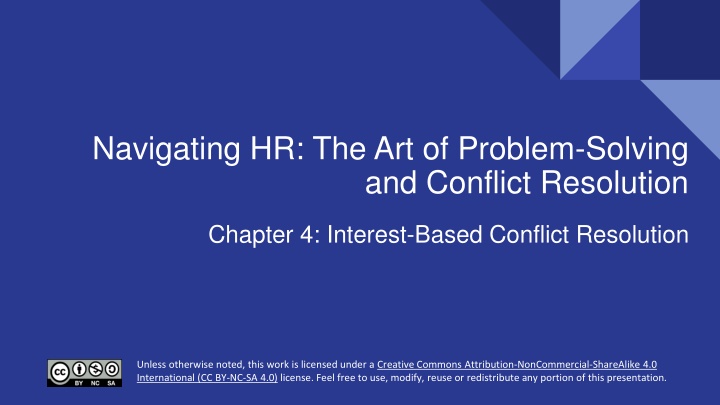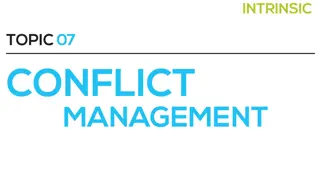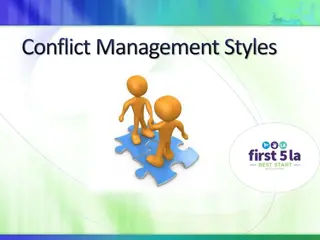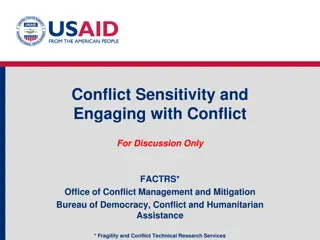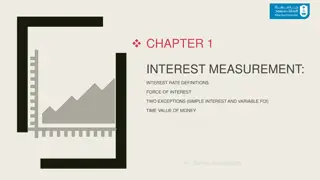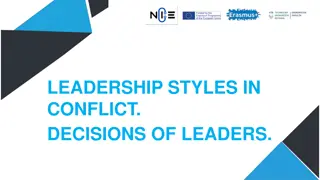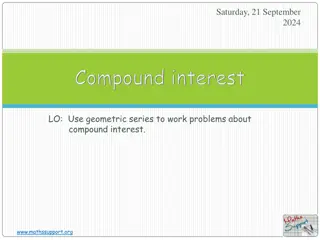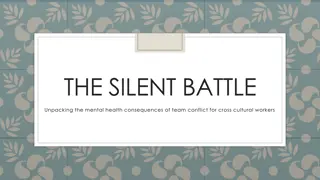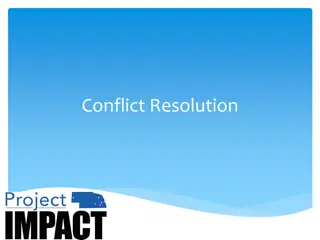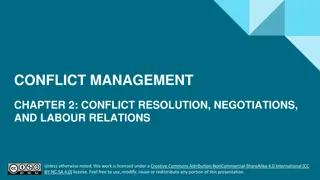Interest-Based Conflict Resolution & Benefits
Dive into Interest-Based Conflict Resolution techniques in HR, distinguishing positions from interests. Explore the benefits & challenges of this approach, emphasizing understanding individual needs for effective conflict resolution strategies.
Download Presentation

Please find below an Image/Link to download the presentation.
The content on the website is provided AS IS for your information and personal use only. It may not be sold, licensed, or shared on other websites without obtaining consent from the author.If you encounter any issues during the download, it is possible that the publisher has removed the file from their server.
You are allowed to download the files provided on this website for personal or commercial use, subject to the condition that they are used lawfully. All files are the property of their respective owners.
The content on the website is provided AS IS for your information and personal use only. It may not be sold, licensed, or shared on other websites without obtaining consent from the author.
E N D
Presentation Transcript
Navigating HR: The Art of Problem-Solving and Conflict Resolution Chapter 4: Interest-Based Conflict Resolution Creative Commons Attribution-NonCommercial-ShareAlike 4.0 International (CC BY-NC-SA 4.0) Creative Commons Attribution-NonCommercial-ShareAlike 4.0 International (CC BY-NC-SA 4.0) Unless otherwise noted, this work is licensed under a Creative Commons Attribution-NonCommercial-ShareAlike 4.0 International (CC BY-NC-SA 4.0) license. Feel free to use, modify, reuse or redistribute any portion of this presentation.
4.0 Learning Outcomes In this chapter, we will: Identify effective techniques to formulate interest-based approaches in conflict resolution List the benefits of an interest-based approach to conflict resolution Apply I statements to a workplace conflict scenario
4.2 The Lesson: Interest-Based Conflict Resolution Interest-Based Approach: Understand the underlying reasons for an individual s position to uncover their actual needs. HR Professional s Role: Uncovering an employee s interests helps solve workplace conflicts. Positions vs. Interests: Positions are the what an individual wants, often sounding like demands. Interests Defined: Interests are the why behind a position, expressing underlying concerns and motivations. Photo by Amy Hirschi, Unsplash License Importance of Interests: Understanding interests provides detailed insight into the individual s true needs.
4.2 Interests versus Positions Position: The manager insists you hire three more team members immediately. Interest: The manager is concerned the team isn t going to fill the customer orders on time, and they may lose their job. Position: One of your employees demands a 4% pay increase during their annual performance review. Interest: This employee recently went through a divorce, and they are concerned about shouldering the cost of living alone. Position: One of your supervisors refuses to participate in a forklift training session this week. Interest: This supervisor witnessed a serious forklift accident at their last job, and they are scared to drive a forklift. Position: An employee says they won t attend the daily staff meeting anymore. Interest: This employee is concerned they will be asked to provide an update on their department s project, and they are fearful of public speaking.
4.2 Benefits of Interest-Based Approach to Conflict Benefits Challenges The focus is on the real concerns and needs of each person There is room for flexibility and creativity There is an opportunity for brainstorming solutions Less focus on positions and more focus on each person interests An opportunity to satisfy the interests of each person involved in the conflict There may be a few challenges to the interest-based approach. It relies on everyone being open to collaboration All parties must openly communicate their interests It takes time to uncover a person s interests Dealing with interests may be more complex than dealing with positions You have to learn how to uncover interests
4.2 Probing Questions Probing Questions: What do you hope to take away? Why do you need this to happen? Why do you want this? What are your concerns? Why is this important to you? How does this support your values? What are your fears? Photo by Marcel Strau , Unsplash License
4.3 Spotlight: I vs You Statements Impact of Statements: Understanding the impact of I versus You statements is crucial for addressing workplace conflict. I Statements: These statements explain concerns, feelings, and consequences without making the listener defensive. You Statements: These statements are accusatory and blameful, causing the listener to become defensive. Confrontation vs. Conversation: You statements may create confrontation rather than generate a conversation. Pressure and Understanding: I statements take the pressure off the other person to defend themselves and help them understand how their behavior impacts others.
4.3 I versus You Examples You Statement: You are always angry. I Statement: When you yell at people, it makes me uneasy, and I can t focus on my work. You Statement: You don t even attend the mandatory team meetings. I Statement: I feel disrespected when you skip our team meeting, and I wonder if you are committed to the team project. You Statement: You are late to work most days. I Statement: When you arrive late to work, we can t start our morning meeting on time, which is unfair to the rest of the team. You Statement: Once again, you have failed to submit your sales report this week I Statement: When you don t submit your weekly sales report, I have to send you an e-mail requesting the document, and I don t have time for this additional administrative work. You Statement: You continue to call in sick every Friday. I Statement: When you call in sick every Friday, your co-workers must complete your work and are already busy doing their work.
4.3 Assertive Communicators Direct and Honest: Assertive communicators are direct, firm, honest, and transparent about their ideas and wants while respecting others ideas. Thoughtful Expression: They express ideas thoughtfully and politely, using I feel statements to resolve disputes without being accusatory. Respectful Communication: Assertive communication is respectful, expressing needs and feelings without guilt or hurting others. Effective Style: This communication style avoids unnecessary conflict and allows for all ideas and views to be shared. Use of I Statements: I statements prevent conflict by avoiding blame and criticism, making the speaker s feelings clear. Accurate Intentions: Effective communication requires precise information from the sender and a receptive, open receiver.
4.3 The Art of the I Statement Formulating I Statements: Creating an I statement involves identifying the behavior causing the issue, its consequences, and how it makes you feel. Preparation: As an HR professional, prepare your I statement before meetings to accurately describe the behavior, consequences, and feelings. Benefits of I Statements: They allow for reflection, take practice, express feelings, and avoid placing blame. Practice Makes Perfect: Regular practice improves your ability to formulate effective I statements. Starting with When : Begin sentences with when instead of you to avoid blame and maintain control of your statements. Impact of Expressing Feelings: Expressing feelings at work can help coworkers understand the impact of their behavior on others.
4.6 Key Takeaways Interest-based conflict resolution focuses on an individual s interests rather than their position. Human Resources professionals can utilize an interest-based conflict resolution approach to uncover the underlying concerns of both sides and find a solution that addresses both parties. It is crucial to ask probing questions to uncover an individual s interests as they may not volunteer their concerns. Use I statements to avoid blaming others. Using I statements helps focus attention on the speaker s thoughts and helps them express how the conflict is impacting them.
